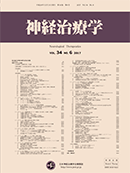33 巻, 2 号
選択された号の論文の73件中51~73を表示しています
メディカルスタッフシンポジウム1:チームで克服する嚥下障害 ~各職種の立場から~
-
2016 年33 巻2 号 p. 215
発行日: 2016年
公開日: 2016/08/10
PDF形式でダウンロード (210K) -
2016 年33 巻2 号 p. 216
発行日: 2016年
公開日: 2016/08/10
PDF形式でダウンロード (222K) -
2016 年33 巻2 号 p. 217-221
発行日: 2016年
公開日: 2016/08/10
PDF形式でダウンロード (644K)
メディカルスタッフシンポジウム2:リハビリテーション最先端 ~先端的治療法による臨床の実際~
-
2016 年33 巻2 号 p. 222
発行日: 2016年
公開日: 2016/08/10
PDF形式でダウンロード (240K) -
2016 年33 巻2 号 p. 223-226
発行日: 2016年
公開日: 2016/08/10
PDF形式でダウンロード (883K) -
2016 年33 巻2 号 p. 227
発行日: 2016年
公開日: 2016/08/10
PDF形式でダウンロード (210K) -
2016 年33 巻2 号 p. 228-233
発行日: 2016年
公開日: 2016/08/10
PDF形式でダウンロード (561K) -
2016 年33 巻2 号 p. 234-238
発行日: 2016年
公開日: 2016/08/10
PDF形式でダウンロード (1325K)
メディカルスタッフシンポジウム3:神経疾患患者の転倒を予防するために ~チームで取り組む転倒予防~
-
2016 年33 巻2 号 p. 239
発行日: 2016年
公開日: 2016/08/10
PDF形式でダウンロード (259K) -
2016 年33 巻2 号 p. 240-244
発行日: 2016年
公開日: 2016/08/10
PDF形式でダウンロード (690K) -
2016 年33 巻2 号 p. 245-249
発行日: 2016年
公開日: 2016/08/10
PDF形式でダウンロード (586K) -
2016 年33 巻2 号 p. 250-254
発行日: 2016年
公開日: 2016/08/10
PDF形式でダウンロード (2833K) -
2016 年33 巻2 号 p. 255-260
発行日: 2016年
公開日: 2016/08/10
PDF形式でダウンロード (1596K)
PMDAジョイントシンポジウム:産官学で拓く神経疾患の治療推進
-
2016 年33 巻2 号 p. 261
発行日: 2016年
公開日: 2016/08/10
PDF形式でダウンロード (246K) -
2016 年33 巻2 号 p. 262
発行日: 2016年
公開日: 2016/08/10
PDF形式でダウンロード (221K) -
2016 年33 巻2 号 p. 263-267
発行日: 2016年
公開日: 2016/08/10
PDF形式でダウンロード (1434K) -
2016 年33 巻2 号 p. 268-272
発行日: 2016年
公開日: 2016/08/10
PDF形式でダウンロード (2640K) -
2016 年33 巻2 号 p. 273-275
発行日: 2016年
公開日: 2016/08/10
PDF形式でダウンロード (1017K)
原著
-
2016 年33 巻2 号 p. 276-279
発行日: 2016年
公開日: 2016/08/10
PDF形式でダウンロード (1417K)
神経治療最前線 海外学会参加報告
-
2016 年33 巻2 号 p. 280-281
発行日: 2016年
公開日: 2016/08/10
PDF形式でダウンロード (1052K)
-
2016 年33 巻2 号 p. 282-285
発行日: 2016年
公開日: 2016/08/10
PDF形式でダウンロード (354K) -
2016 年33 巻2 号 p. 287
発行日: 2016年
公開日: 2016/08/10
PDF形式でダウンロード (146K) -
2016 年33 巻2 号 p. 288
発行日: 2016年
公開日: 2016/08/10
PDF形式でダウンロード (131K)
